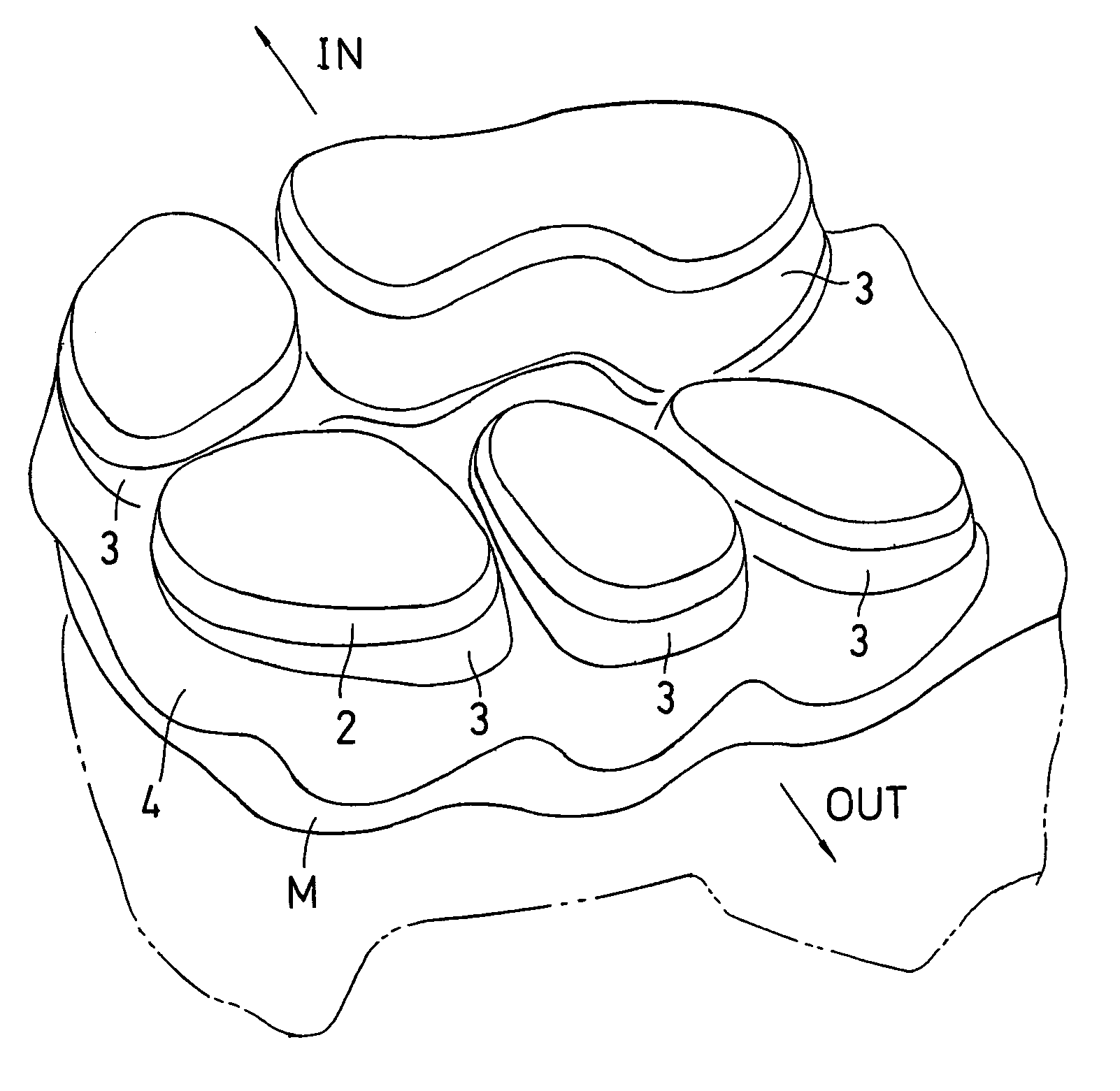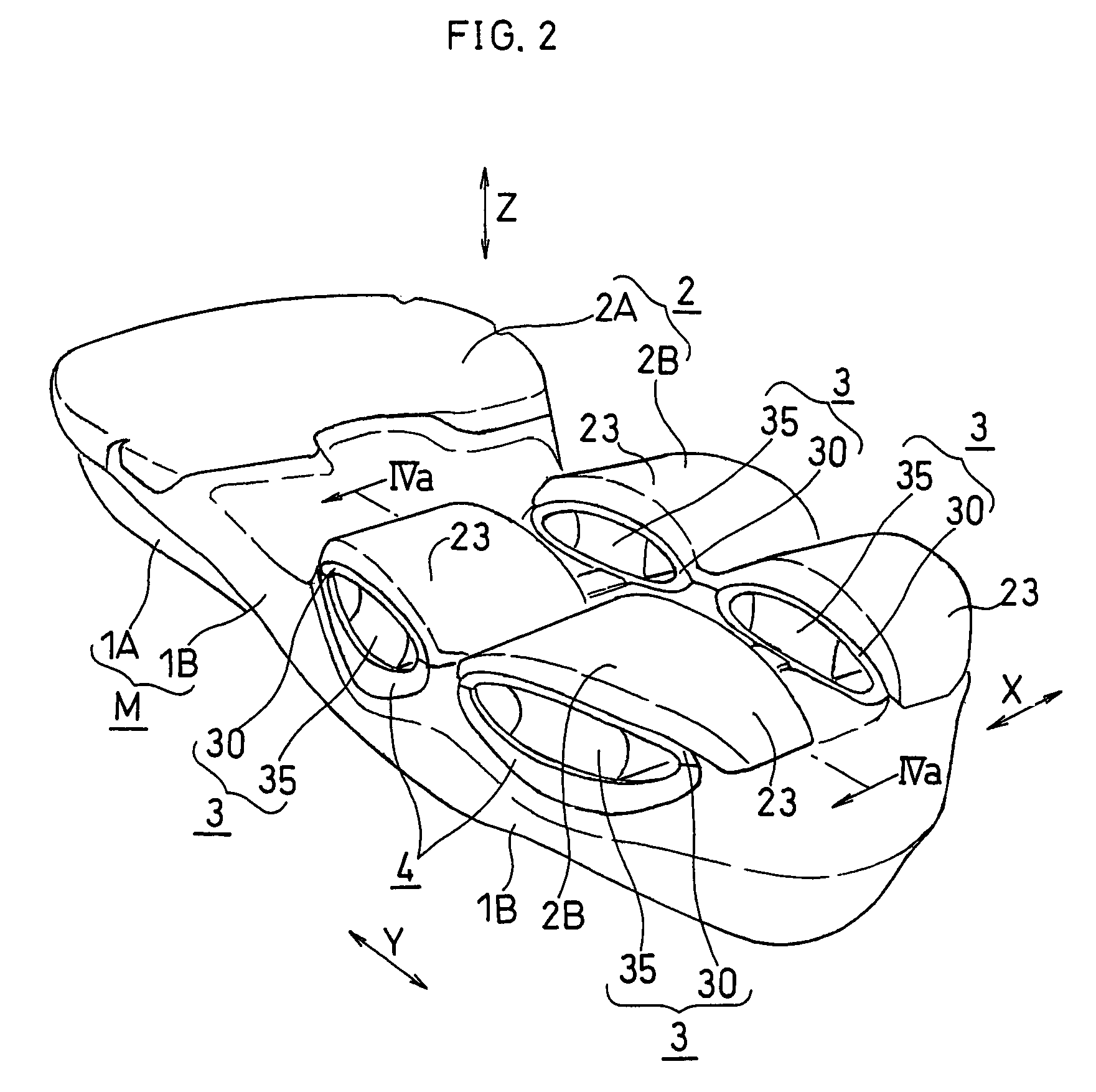Shock absorbing device for shoe sole in rear foot part
a technology of shock absorption device and shoe sole, which is applied in the direction of shoes, top-pieces, heels, etc., can solve the problems of difficult deformation of the foot part of the shoe sole, large impact load on the lateral side of the heel, and no document discloses a point, etc., and achieves the effect of easy abduction or abduction of the foo
- Summary
- Abstract
- Description
- Claims
- Application Information
AI Technical Summary
Benefits of technology
Problems solved by technology
Method used
Image
Examples
first embodiment
[0119]FIGS. 1 to 4 show the first embodiment of the present invention.
[0120]As shown in FIG. 1, a shoe sole of this embodiment includes a midsole (an example of a support element) M, an outer sole 2 and deformation elements 3. The midsole M is formed by vertically bonding a first midsole body 1A which is arranged in an upside and a second midsole body 1B which is arranged in a downside. The outer sole 2, a so-called shank (not shown) etc. are disposed on bottom surfaces of the midsole bodies 1A, 1B. An insole (not shown) is bonded onto the first midsole body 1A. Each midsole body 1A, 1B is, for example, formed of a material suitable for shock absorption, such as resin foam of EVA (ethylene-vinyl acetate copolymer), polyurethane or the like. Above the midsole M and the insole, an upper U that is suitable for covering the instep of the foot is disposed. The outer sole 2 that gets contact with the ground surface or the floor surface at the time of landing is formed of a material having...
second embodiment
[0161]FIG. 5 shows the second embodiment. Note that, in the description of the following embodiments, the parts which are identical or corresponding to those of the first embodiment are designated by the same reference numerals as the first embodiment and the detailed description thereof will be omitted.
[0162]In this embodiment, as shown in FIG. 5, the deformation elements 3 is also provided on the medial and lateral sides of the fore foot part of the foot in addition to the rear foot part of the foot. This deformation element 3 consists of the tubular part 30. That is, unlike the first embodiment, there is no cushioning member within the tubular part 30, and therefore, the tubular part 30 is hollow on the inside.
[0163]In this embodiment, the connecting member for retaining the tubular part 30 is not provided, and the upper portion 32 of the tubular part 30 (lower half of the tubular part 30 in FIG. 5) is directly fit into the second curved surface 12 of the midsole M. The upper por...
third embodiment
[0165]FIGS. 6 to 8 shows the third embodiment. In the figures, the arrow IN indicates the direction toward the medial side of the foot, the arrow OUT indicates the direction toward the lateral side of the foot, the arrow F indicates the direction toward the front of the foot and the arrow B indicates the direction toward the rear of the foot.
[0166]In this embodiment, as shown in FIG. 6, a plurality of generally columnar deformation elements 3 are provided. The connecting member 4 for retaining these deformation elements 3 is provided to be continuous along a side face of the rear foot part of the foot.
[0167]FIG. 7 is an exploded perspective view of the deformation elements 3, the connecting member 4 and so on in the rear foot part of the foot.
[0168]In this embodiment, as shown in FIG. 7, three deformation elements 3 are provided in the rear foot part. The upper and bottom surfaces of each deformation element 3 are formed to be flat (uncurved).
[0169]The first deformation element 301 ...
PUM
 Login to View More
Login to View More Abstract
Description
Claims
Application Information
 Login to View More
Login to View More - R&D
- Intellectual Property
- Life Sciences
- Materials
- Tech Scout
- Unparalleled Data Quality
- Higher Quality Content
- 60% Fewer Hallucinations
Browse by: Latest US Patents, China's latest patents, Technical Efficacy Thesaurus, Application Domain, Technology Topic, Popular Technical Reports.
© 2025 PatSnap. All rights reserved.Legal|Privacy policy|Modern Slavery Act Transparency Statement|Sitemap|About US| Contact US: help@patsnap.com



